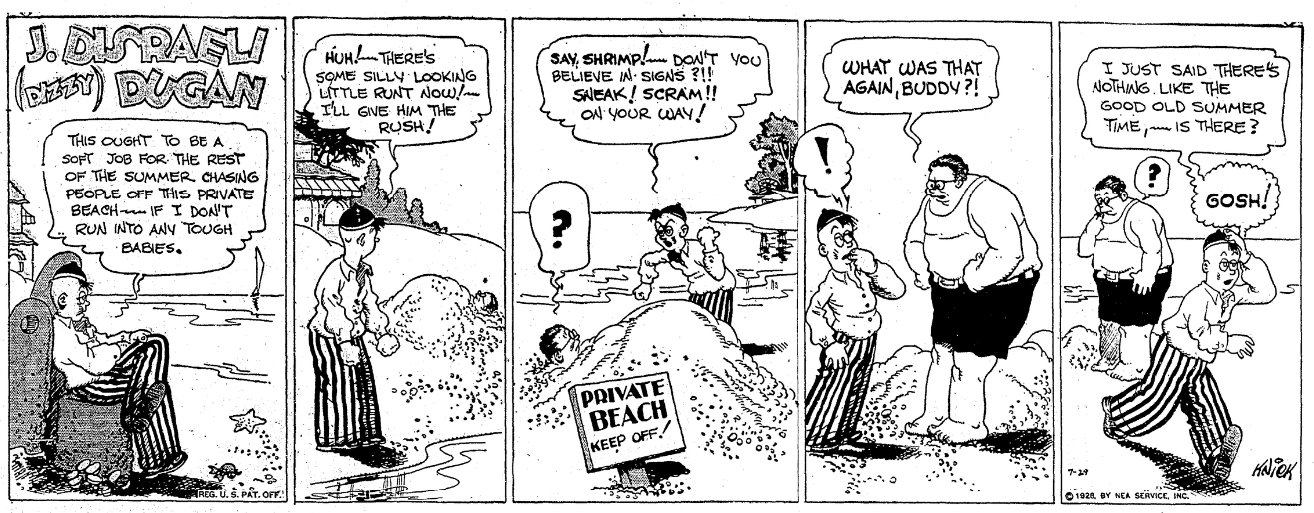29 August 2022
To scram is to depart quickly from a place, and it frequently appears in the imperative. The etymology, like that of most slang terms, is not known for certain, but it is probably a clipping of the verb to scramble, perhaps influenced by the German verb schrammen, meaning to run away.
The earliest use of scram that I have found is in the form to scram and scrow, in a column by Walter Winchell that appeared in Variety on 20 April 1927. (The column probably appeared several weeks earlier in the New York Evening Graphic, the paper for which Winchell primarily wrote at the time, but I don’t have access to that archive.) The voice is that of Joe Zilch, one of Winchell’s fictional characters:
Well, anyway, honey started to cry, like she always cries, and I thought maybe she would scram and scrow on me back to her mother, who don’t like me because I’m an atheist.
Scrow has many different senses in various English and Scottish dialects, most commonly used to refer to a commotion or state of disorder, but the sense that seems to fit the context is its use as a verb meaning to scatter.
The following year Winchell would credit one of his Broadway sources, Jack Conway, with the coinage of scram, but I have been unable to find any instances where Conway is quoted using the word. We have no reason to doubt that Conway was Winchell’s source for the word, but he was probably just the conduit, not the actual coiner.
Scram and scrow make another appearance in Variety a year later on 14 March 1928, this time in an advertisement for the play Dressed to Kill:
They pull a job at a fur store which woulda worked but for the skirt, who is got a load of S.A., and she’s carrying’ a torch for some sap. But she is a ham and can’t go thru with it. The answer is that the mob is got to scram and scrow before the oppercays ankle along and in the end the big shot gets knocked off because the mob figures he crossed them on account of this femme, for whom he’s got a letch.
We see plain old scram in the comic strip J. Disraeli (Dizzy) Dugan, penned by Irving S. Knickerbocker, on 28 July 1928, in which Dugan, charged with keeping people off a private beach, tells a man to leave:
Say, Shrimp!—Don’t you believe in signs?!! Sneak! Scram!! On your way!
With the dawn of the nuclear age in the 1940s, scram took on a new meaning, that of conducting an emergency shutdown of a nuclear reactor. This sense is first recorded in the February 1950 issue of the journal American Speech:
One of the most interesting applications of all is the combination of the verb to scram with the noun level into scram-level, meaning the point of neutron intensity at which the reactor is “scrammed”—shut down, automatically or otherwise.
And later that year, this sense of scram began appearing in newspapers. From an Associated Press piece from 17 July 1950:
The reactor has a safety valve. This comprises two handles set on the wall. They are not electronic. They can be moved by human hands. They will dump a load of shot down a hole into the middle of the reactor.
This is no ordinary shot. It is boron-steel and the boron absorbs neutrons, atomic sparks which make the atomic heat chain reaction. The boron shot quenches the neutrons like water on a fire and just as fast.
The handles are named “scram control,” meaning the sort of danger that makes you want to run. This reactor cannot possibly explode, but it can melt, and that would cost millions of dollars, plus a risk of radioactive contamination at the site.
But oral use of this nuclear sense probably dates to the very first nuclear reactor at the University of Chicago in December 1942. An article on nuclear terminology written by Francois Kertesz in September 1968 for the Oak Ridge National Laboratory tells the story and gives the reason why such a shutdown is called a scram:
Another, still widely used term became part of the technical language at the birth of the atomic age. During the experiment that culminated on December 2, 1942 in the accomplishment of the first controlled nuclear chain reaction, a safety rod was held by a rope running through the pile and weighted at the opposite end. The young physicist in charge was told to watch the indicator; if it exceeded a certain value, he was to cut the rope and scram. Since then the term scram is used to designate the emergency shutdown of a reactor. Today the urgency is lost and the word scram indicates simply a fast-shutdown operation.
Sources:
Blakeslee, Howard W. “New Atomic Plant Is Ready to Work” (Associated Press). Jackson Sun (Tennessee), 17 July 1950, 7. ProQuest Historical Newspapers.
Green’s Dictionary of Slang, 2022, s.v. scram, v.
Kertesz, Francois. The Language of Nuclear Science (pdf). Oak Ridge National Laboratory (ORNL-TM-2367), 17 September 1968, 21.
Knickerbocker, Irving S. “J. Disraeli (Dizzy) Dugan.” Newspaper Enterprise Association. Sacramento Bee, 28 July 1928, comic section 3. Readex: America’s Historical Newspapers.
Lockard, E.N. “Fertile Virgins and Fissile Breeders: Nuclear Neologisms.” American Speech, 25.1, February 1950, 27. JSTOR.
“Overheard at the Double-Crossroads of the Underworld” (advertisement). Variety, 14 March 1928, 17. Variety Archives.
Oxford English Dictionary, second edition, 1989, s.v. scram, v.2, scram, v.3.; draft additions, 1993, s.v. scrow, n.
Winchell, Walter. “Walter Winchell and Joe Zilch” (2–4 April 1927). Variety, 20 April 1927, 31. Variety Archives.
Wright, Joseph. The English Dialect Dictionary, vol. 5 of 6. Oxford: Henry Frowde, 1905, 287–89, s.v. scrow(e, sb. and v., scroo, v. and sb., scrow, sb. and v.
Image credits: Scram button: Alan Levine, 2011, licensed under a Creative Commons Attribution 2.0 Generic license; Dizzy Dugan comic: Irving S. Knickerbocker, 1928, public domain image.


